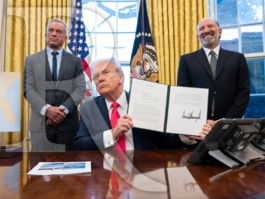Time Is On My Side: The Nomination Gap
A Commentary By Michael Baudinet
Much has been made in the past of presidential candidates' campaign theme songs, but there would be no more appropriate choice for this year's Republican nominee, John McCain, than the Rolling Stones' classic, "Time Is on My Side." Political observers, including your Crystal Ball, are virtually unanimous in their assessment that the prevailing conditions this fall are ideal for sending a Democrat to the Oval Office. We have, however, argued here that McCain can still win, and he has one built-in advantage over his eventual opponent that bears noting--time.
John McCain was the Republican standard-bearer for three months while Barack Obama and Hillary Clinton continued to battle for the Democratic nomination. This afforded him several key opportunities: first, it allowed his (comparatively) impoverished campaign the opportunity to raise money, while his Democratic opponents spent their resources against each other, rather than him. Second, it gave him time to work toward bringing the GOP's disgruntled conservative base into his camp. Third, it provided him the first opportunity to define himself and his opponents. For example, one of his first acts after securing the nomination was to take a tour abroad--meeting foreign leaders, visiting Iraq, etc.--to solidify his appearance as the experienced statesman and, in a sense, run as the incumbent. Clearly the additional time had value to McCain, but how much has it helped historically?
The short answer is that this nomination gap helps enormously. In fact, in nine of the last ten presidential elections, the candidate that has been able to turn his attention from the nomination to the general election first has gone on to win the popular vote.
|
Year |
Popular Vote Winner |
Nomination Gap |
Popular Vote Margin |
|
1968 |
Nixon |
21 days |
0.7 percent |
|
1972 |
Nixon |
94 days |
32.2 percent |
|
1976 |
Carter |
69 days |
2.1 percent |
|
1980 |
Reagan |
78 days |
9.7 percent |
|
1984 |
Reagan |
116 days |
18.2 percent |
|
1988 |
G. H. W. Bush |
42 days |
7.8 percent |
|
1992 |
Clinton |
-113 days |
5.6 percent |
|
1996 |
Clinton |
36 days |
8.5 percent |
|
2000 |
Gore |
1 days |
0.5 percent |
|
2004 |
G. W. Bush |
43 days |
2.5 percent |
Skeptics will argue that the nomination gap advantage simply reflects other strengths of a candidate, like incumbency, making the phenomenon more of a coincidence than a cause. A closer look at these examples, however, suggests a stronger, causal link. When Jimmy Carter lost the 1980 election while serving as the sitting president, his opponent, Republican Ronald Reagan, enjoyed a 78 day nomination gap. Furthermore, in all three elections in this period in which no incumbent was on the ballot (1976, 1988, and 2000), the candidate who enjoyed a nomination gap advantage went on to win the popular vote. Far from being a mere coincidence, the nomination gap model takes incumbency advantages into account while also explaining upset victories and outcomes when no incumbent is running.
In the majority of cases, one candidate, either because of incumbency or prestige within his party, has been able to lock up the nomination well before his general election opponent. As we have already noted, in 1980, Ronald Reagan defeated the incumbent Jimmy Carter by a comfortable, nearly 10 point margin in the popular vote. And while there are a number of factors that contributed to Reagan's victory, we note that Reagan sewed up the nomination in May, during which time a determined challenge by Senator Edward Kennedy of Massachusetts kept President Carter focused on securing re-nomination up until the convention itself.
Carter himself had benefited only four years earlier from the nomination gap. Having clinched the Democratic nomination more than two months prior to President Gerald Ford's convention victory over Ronald Reagan, Carter opened up a huge 33 point lead in the polls. While Ford managed to come nearly all the way back, Carter's nomination gap helped him build what proved to be an insurmountable lead.
In 1996, incumbent President Bill Clinton was uncontested for his party's nomination, and although his Republican opponent, Bob Dole, clinched his party's nomination by March, Clinton was reelected by a comfortable margin. The 2004 campaign followed a similar pattern, as the unchallenged incumbent George W. Bush bested Democrat John Kerry, albeit by a smaller margin. Bush's father, George H.W. Bush, was elected in 1988 when, as the sitting vice-president, he enjoyed a month-long nomination gap advantage over the Massachusetts governor, Michael Dukakis.
In 1972 and 1984, incumbents Richard Nixon and Ronald Reagan, respectively, never faced any serious nomination challenge while their opponents remained embroiled in nominating contests into June. Both Nixon and Reagan cruised to landslide victories in the general election with enormous popular vote margins.
By this time, we should not be surprised to discover that the two closest elections in popular vote terms were also the two with the shortest nomination gaps. In 1968, neither Republican Richard Nixon nor Democrat Hubert Humphrey was assured the nomination until the convention itself. The Republican convention, held three weeks before the Democratic convention, provided a small nomination gap for Nixon, who went on to edge Humphrey by a 0.7 percent margin. The shortest nomination gap of all came in the 2000 presidential election, when Al Gore and George W. Bush's chief rivals dropped out on consecutive days following that year's Super Tuesday primary. While we caution the reader about reading causation into coincidence, we will note that Bill Bradley, Gore's rival, dropped out one day before Bush's rival, McCain; despite losing in the Electoral College, Gore did win the popular vote.
The outlier in this sequence is, of course, 1992. The first President Bush, although having to deal with a stronger-than-expected right-wing challenge from Pat Buchanan, never had his re-nomination seriously threatened. By contrast, the eventual winner, Bill Clinton, earned his reputation as the "Comeback Kid" as he recovered from a third-place finish in Iowa to secure the nomination in the late spring. Despite one of the longest nomination gap disadvantages, Clinton eventually won with a 5.6 percent edge over President Bush. It should be noted, however, that because of the strong third party candidacy of Texas businessman H. Ross Perot, Clinton won only a 43 percent plurality. It is possible that the three-way race shifted the dynamics of the race in such a way as to enable Clinton to overcome Bush's nomination gap, although we could still point to a myriad of other reasons for Clinton's eventual victory.*
So what does this mean for John McCain in 2008? In a campaign where nearly every historical indicator points against him, he does have at least one phenomenon working in his favor, and it does have real benefits. By the time Hillary Clinton conceded on June 7, McCain had a 95 day edge (had the Democrats require a brokered convention, it would have become a 174 day advantage). Here, history appears to give McCain the upper hand. So while the Straight Talk Express blares "Time Is On My Side," Obama will focus on telling voters that, come November, "you'll come running back to me."
* 1968 was also a three way race. George Wallace received 13.5 percent of the vote, while Nixon won with 43.4 percent. This election, however, followed the pattern as the Nixon also held the nomination gap edge.
Michael Baudinet is the Executive Assistant to the Director at the University of Virginia Center for Politics and a special contributor to the Crystal Ball.
COPYRIGHT 2008 THE PROVIDENCE JOURNAL CO.
DISTRIBUTED BY CREATORS SYNDICATE, INC.
Views expressed in this column are those of the author, not those of Rasmussen Reports.
See Other Political Commentary.
Rasmussen Reports is a media company specializing in the collection, publication and distribution of public opinion information.
We conduct public opinion polls on a variety of topics to inform our audience on events in the news and other topics of interest. To ensure editorial control and independence, we pay for the polls ourselves and generate revenue through the sale of subscriptions, sponsorships, and advertising. Nightly polling on politics, business and lifestyle topics provides the content to update the Rasmussen Reports web site many times each day. If it's in the news, it's in our polls. Additionally, the data drives a daily update newsletter and various media outlets across the country.
Some information, including the Rasmussen Reports daily Presidential Tracking Poll and commentaries are available for free to the general public. Subscriptions are available for $4.95 a month or 34.95 a year that provide subscribers with exclusive access to more than 20 stories per week on upcoming elections, consumer confidence, and issues that affect us all. For those who are really into the numbers, Platinum Members can review demographic crosstabs and a full history of our data.
To learn more about our methodology, click here.



